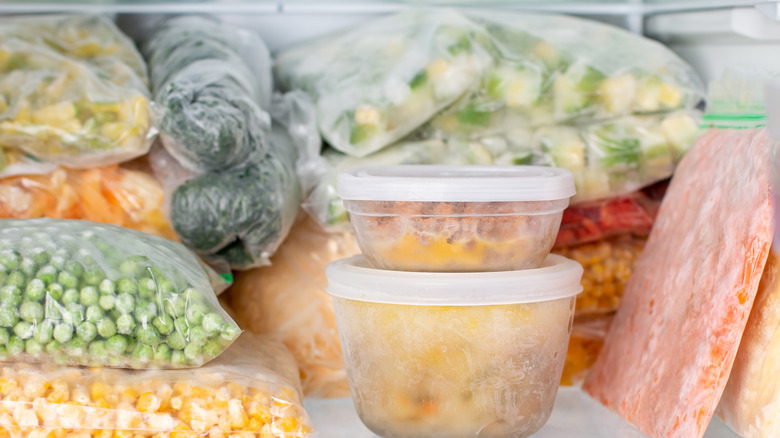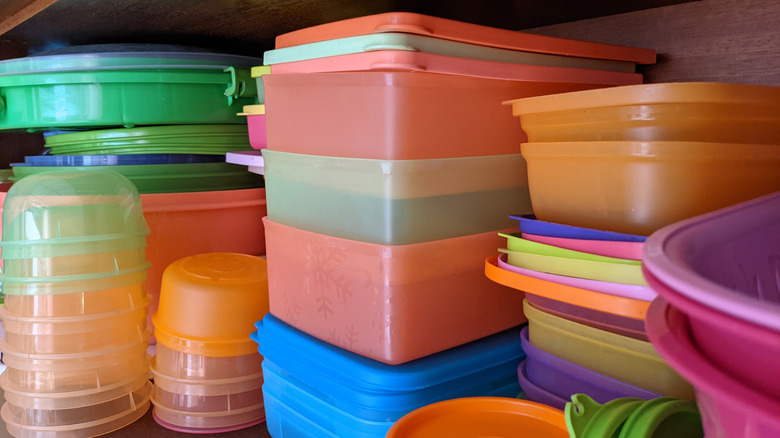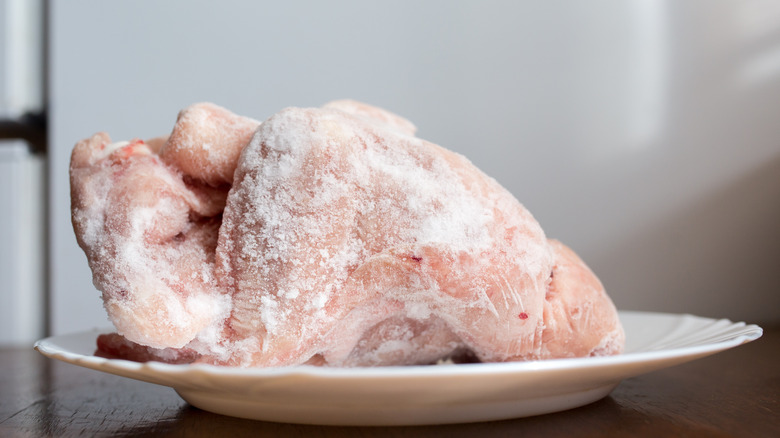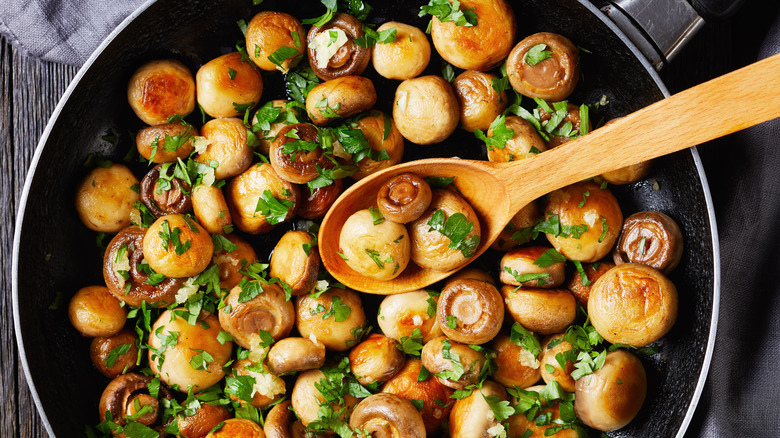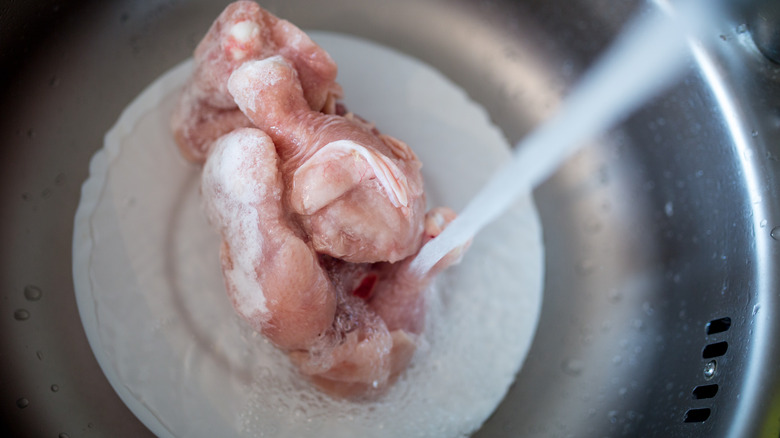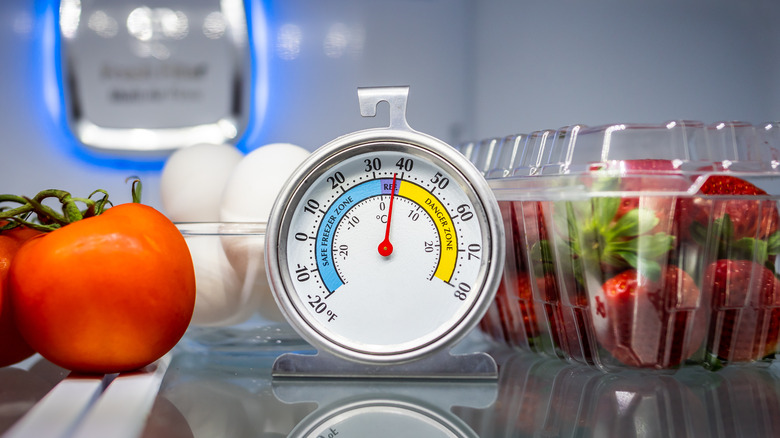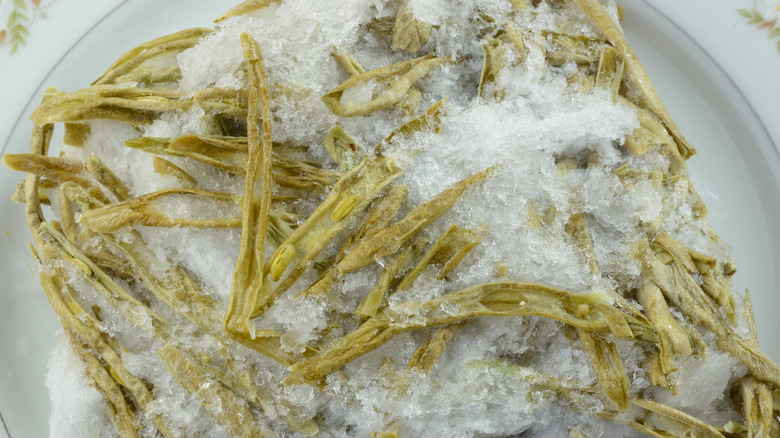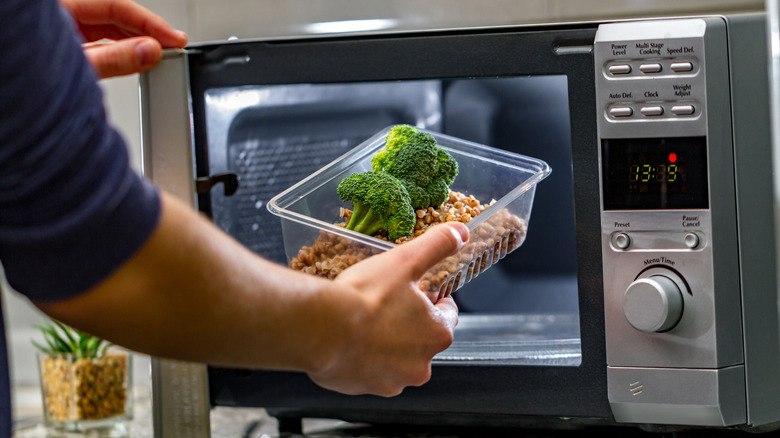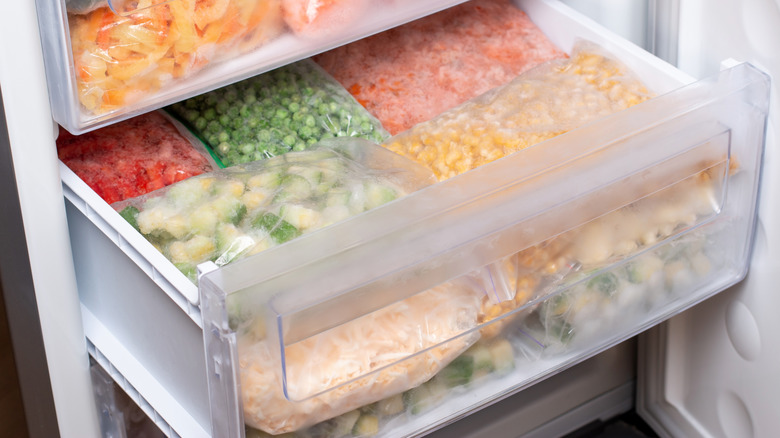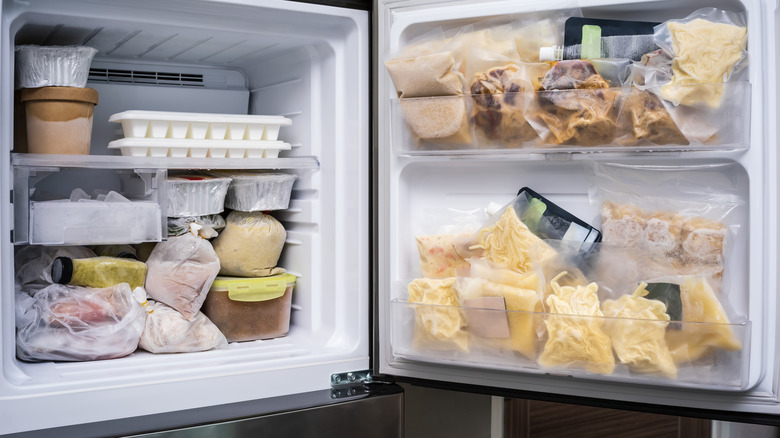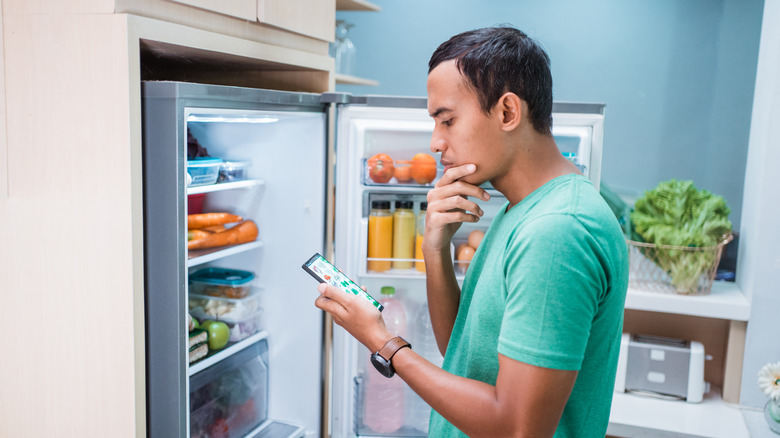Big Mistakes Everyone Makes With Frozen Foods
When's the last time you cleaned your freezer? Has it been months or years? Have you even used any food in the freezer in the past week? It's not unlikely you've been breaking a few freezer guidance rules, and just because everyone is doing it doesn't make it smart. Although having a freezer is convenient, we often forget about that chicken breast we tossed in six months ago. And maybe you leave frozen food out on the counter — oh dear.
It's not likely anyone is thoroughly reading USDA guidance, and teaching food safety in school is a rarity. And there are also myths and reality: For example, freezing food will not kill bacteria, as some people believe. But it's important to know the rules, and being worried about food poisoning can take the fun out of cooking when you don't know where to start with frozen food safety.
We're here to help with only a little chastising. We'll make it clear which no-nos are big mistakes and which ones aren't, so you don't have to panic figuring out at the last minute how to defrost that Saturday night steak.
Using old, non-airtight tupperware and storage
Perhaps you're still using that tupperware you got from your favorite takeout place three years ago. The reason you keep getting freezer burn whenever you use that iffy container is because it's likely not airtight. When containers aren't airtight, moisture can get into the food and result in ice crystals. Freezer burn isn't exactly dangerous, but it does affect the quality of your food. Meat will become dry and tough, and vegetables will shrink, according to Healthline. Sound appetizing? Luckily, if you do find freezer-burned items, you can just cut away the affected parts, according to the Food Safety and Inspection Service (FSIS).
The New York Times recommended the best containers to use to prevent freezer burn, including Ziploc bags, heavy silicone freezer bags, or airtight containers that lock. But after that investment, don't get lazy with packing up your leftovers. "If you're freezing a meal with several components that will freeze and thaw at different rates, such as chicken and broccoli, take the time to pack them separately," per Anna Perling of The New York Times.
Leaving food to thaw on the counter
We've all been there: throwing that cut of steak on the counter in the morning to make sure it's ready to go by 5 p.m. dinner. But the Food Safety and Inspection Service (FSIS) recommends always thawing food in the fridge for safety. If food is left out of the fridge, food is put into what the FSIS calls "the danger zone": when food is between 40 degrees and 140 degrees for too long. For defrosting food fast, there are three safe methods: the fridge, cold water, or microwave.
What happens when you eat food that's been in the danger zone? You may be at risk for food-borne illness. You know, food poisoning and even worse. There's no need to get more descriptive with these illnesses.
Although it's okay to refreeze raw foods, make sure you freeze them within two hours of defrosting or one hour in temperatures above 90 degrees. Wondering about leftovers? They can be frozen within one to three days of being cooked.
Making frozen vegetables soggy when defrosting
The reason why most people hate frozen veggies is they don't seem to live up to their fresher counterparts. "Frozen vegetables tend to release water quickly and can end up quite mushy if done improperly," William Goldfield, director of corporate communications at Dole Food Company, Inc. told Martha Stewart. But they can really turn out to be just as good — you just need to defrost them the right way. There are a couple of ways to defrost your veggies to ensure they're crispy and fresh.
If you have the time, defrost them in the refrigerator. Place packaged vegetables in a container to avoid condensation, and put them on the top shelf, as they defrost at a lower temperature than meat. Squeezing vegetables like kale also rids them of condensation that might keep them soggy while cooking.
Martha Stewart also noted that veggies can go straight from the freezer to the fryer, stovetop, or oven. Water-heavy veggies like spinach and onion should be sauteed for the best results, while broccoli and cauliflower are ideal when roasted in the oven.
Not properly defrosting foods with water
We're having flashbacks to Thanksgiving day and realizing the turkey hasn't been defrosted. There's always the temptation to use the hottest water you can to get the meat to defrost faster, but the FSIS says hot water is a no-go. Hot water puts food at risk for being in the danger zone and puts whoever eats it in danger of getting food poisoning.
But don't think it's that easy to defrost that giant turkey overnight in cold water. The water needs to be changed every 30 minutes so it stays cold while the meat is defrosting. The meat should also be in an airtight plastic bag to make sure bacteria doesn't escape into the water it's sitting in. Refilling the cooler holding your big chicken or turkey isn't the easiest way to defrost it, so you may want to plan ahead to allow your turkey to defrost in the fridge.
Not paying attention to how cold the freezer is
It's easy to depend on a fridge and freezer that came with your house or in the apartment you're renting. It may not even cross your mind to check how cold that old freezer is — and if it's not cold enough, it can put your food at risk, according to the FSIS. It's very easy to get into the habit of paying attention to the temp of your hefty appliance. Buy a simple freezer thermometer and make sure it's at 0 degrees. The FDA notes that the fridge should also be below 40 degrees to slow bacterial growth.
Freezing food does not kill bacteria, even at the correct temperature. Bacteria lay dormant when frozen and "reactivate" when they're thawed, which means food needs to be immediately cooked, tossed, or put into the fridge. Otherwise, you could put yourself at risk of food poisoning.
Freezing food for way too long
It's easy to fall into the habit of tossing everything into the freezer — leftovers, extra food, and extra groceries. However, it's just as easy to forget the food you've put in there. The next time you search through the freezer and find something that's a surprise, think about when you might have put it in there.
It's not dangerous to store food for a longer amount of time, but it does decrease the quality of the food (per FSIS). Not surprisingly, meats and vegetables have the shortest duration in the freezer before the condition deteriorates, according to foodsafety.gov. This website has a food duration chart for almost anything you may put in your freezer. There are even some suggestions for food that never freezes well, such as salads, whole eggs, and custard pies.
More surprising is the fact that shrimp and crayfish can be frozen up to 18 months. Who knew?
Only using a microwave to defrost your food
We've all tossed that meat in the microwave and hit the defrost button. What else would the defrost button be there for other than magically getting your food to you faster? Thrillist talked to microwave expert Bob Schiffmann and found that the defrost setting on a microwave is really just the microwave setting "pulsing" between 100% and 0% power. To contrast, time cook is always at 100% power.
"Everyone's trying to differentiate their oven. So they put more buttons and more functions. They're all trying to outdo one another," Schiffmann told Thrillist.
This puts food in the defrosting microwave at risk of becoming cooked around the edges while the inside stays frozen. Sound appetizing? It gets worse. According to Michigan State University, defrosting food in the microwave puts food at risk of being in the danger zone — between 40 degrees and 140 degrees — and breeding more bacteria. It's best to always take the temperature of the food you're going to cook to make sure it's the safe temperature.
Forgetting to throw out frozen food after a power outage
The danger zone temperatures (between 40 degrees and 140 degrees) even mean that you'll need to pay attention to when your freezer is shut off or out of order. The most common predicament people face are power outages, rendering the freezer useless. If a power outage doesn't last long — say, just a flash of power loss — it makes no difference. However, if it's more than two hours, you'll need to check your freezer temperature, which is why a thermometer is handy. Any food that is in a freezer that's at 40 degrees for more than two hours is at risk of causing food-borne illness.
According to foodsafety.gov, most meats — including pizza with toppings, poultry, or leftover cooked meat — need to be discarded once they're held at that temperature for more than two hours. However, processed cheeses and fresh fruits are okay to keep. Surprisingly, one fruit that stands out is coconut (sliced or shredded). It needs to be discarded after two hours in the danger zone.
Keeping the refrigerator and freezer doors closed during a power outage does help keep it cool, according to the FDA. Last resort, dry or block ice in the freezer can ensure it'll be as cold as possible if you expect the power to be out for a long amount of time.
Keeping your freezer too empty or too full
The worst energy sucker for a freezer is opening the door since it will have to make up for the cold air that escaped. However, you can ensure your freezer is as efficient as possible by keeping it full, according to HomeSteady. When the items in the freezer become fully frozen, they help to keep the freezer at a low temperature. But wait — you can fill your freezer up too much, too, so don't go overboard. An overfull freezer will commonly cause the sensor to read the temperature correctly, which can cause problems.
If you don't have enough food to fill your freezer for maximum energy efficiency, HowStuffWorks recommends filling the empty space with newspaper, bags of shipping peanuts, or even Ziploc bags filled with water. You can also do a complete overhaul and defrost your freezer, let it dry out, and move the food you grab most often to the sides and front of your freezer. In the middle, put less commonly used foods. When the freezer is organized as such with air space around the edges and top of the food items, it allows for maximum energy efficiency since the food in the middle will help keep the freezer cold.
Not keeping track of what's in the freezer
Can you name all the items in your freezer off the top of your head? We didn't think so. Maybe you haven't even used any of them just because you have no idea what's in there. The best way to maximize freezer efficiency and keep you (and any guests) safe is to keep track of what's in your freezer at all times. This can just mean adding labels to the bags and containers of the food you already have in there.
Good Cheap Eats recommends keeping a continuous inventory for your freezer. Whether it's an app, a dry-erase board, or paper, make sure to keep track of the quantity of food you have and the date it was put into the freezer. When you do this, you can avoid guessing what you have in there, keep up your freezer efficiency, and avoid food waste. It also helps you know what you do and do not have before making a grocery run.
